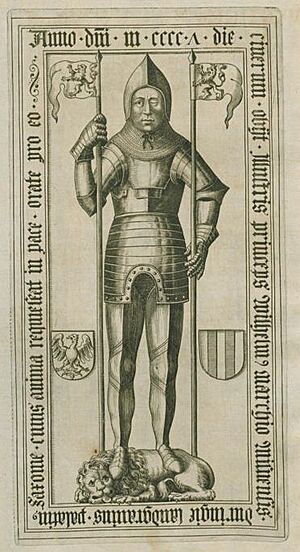William I, Margrave of Meissen facts for kids
Quick facts for kids William I, Margrave of Meissen |
|
|---|---|
 |
|
| Spouse(s) | Elizabeth of Moravia Anna of Brunswick-Lüneburg |
| Noble family | House of Wettin |
| Father | Frederick II, Margrave of Meissen |
| Mother | Mathilde of Bavaria |
| Born | 19 December 1343 Dresden |
| Died | 9 February 1407 (aged 63) Grimma Castle |
William I, also known as "William the One-Eyed," was an important ruler in a region called Meissen. He was born in Dresden on December 19, 1343, and passed away in Grimma Castle on February 9, 1407. His nickname comes from a story. It says that Saint Benno appeared to him in a dream. This happened because William had disagreements with the Church. In the dream, he supposedly lost an eye.
Contents
Early Life and Family
William was the son of Frederick II, Margrave of Meissen and Mathilde of Bavaria. He belonged to the powerful House of Wettin. This family ruled over many lands in Germany for centuries.
William ruled his lands alongside his older brothers. This shared rule continued until 1382.
The Division of Chemnitz
In 1381, William's brother, Frederick III, passed away. The remaining brothers then decided to divide their lands. This agreement was called the Division of Chemnitz. It happened in 1382.
Through this division, William received the Margraviate of Meissen. A margraviate was a special kind of territory. It was often located on the border of a larger kingdom. The ruler of a margraviate was called a Margrave.
William's Rule and Achievements
William was known as a very active and clever ruler. He worked hard to strengthen his power in Meissen. He also defended his lands against the House of Luxembourg from Bohemia.
Expanding His Lands
William managed to add new territories to Meissen. He acquired the rule of Colditz. He also gained control of the rich lands of the Burgraviate of Dohna. A burgraviate was a territory ruled by a burgrave, a type of count.
He bought these lands after a conflict known as the Dohna Feud. This showed his skill in managing his territory.
Supporting the Church
William was a great supporter of the Meissen Cathedral. He helped the cathedral gain special independence from some church rules. This was called an "exemption."
In 1404, William also founded a new monastery in Dresden. It was for the Augustinians, a group of monks. He made sure the monastery had enough land and wealth to thrive.
Marriages and Succession
William I was married twice. His first wife was Elizabeth of Moravia. She passed away in 1400.
After her death, he married his second wife, Anna of Brunswick. She was the daughter of Otto I of Brunswick.
Neither of William's marriages had children. This meant he had no direct heirs to take over his lands.
Who Inherited His Lands?
When William passed away in 1407, his lands went to his nephews. These nephews were Frederick the Peaceful, Frederick the Belligerent, and William the Rich. They continued the rule of the House of Wettin.

